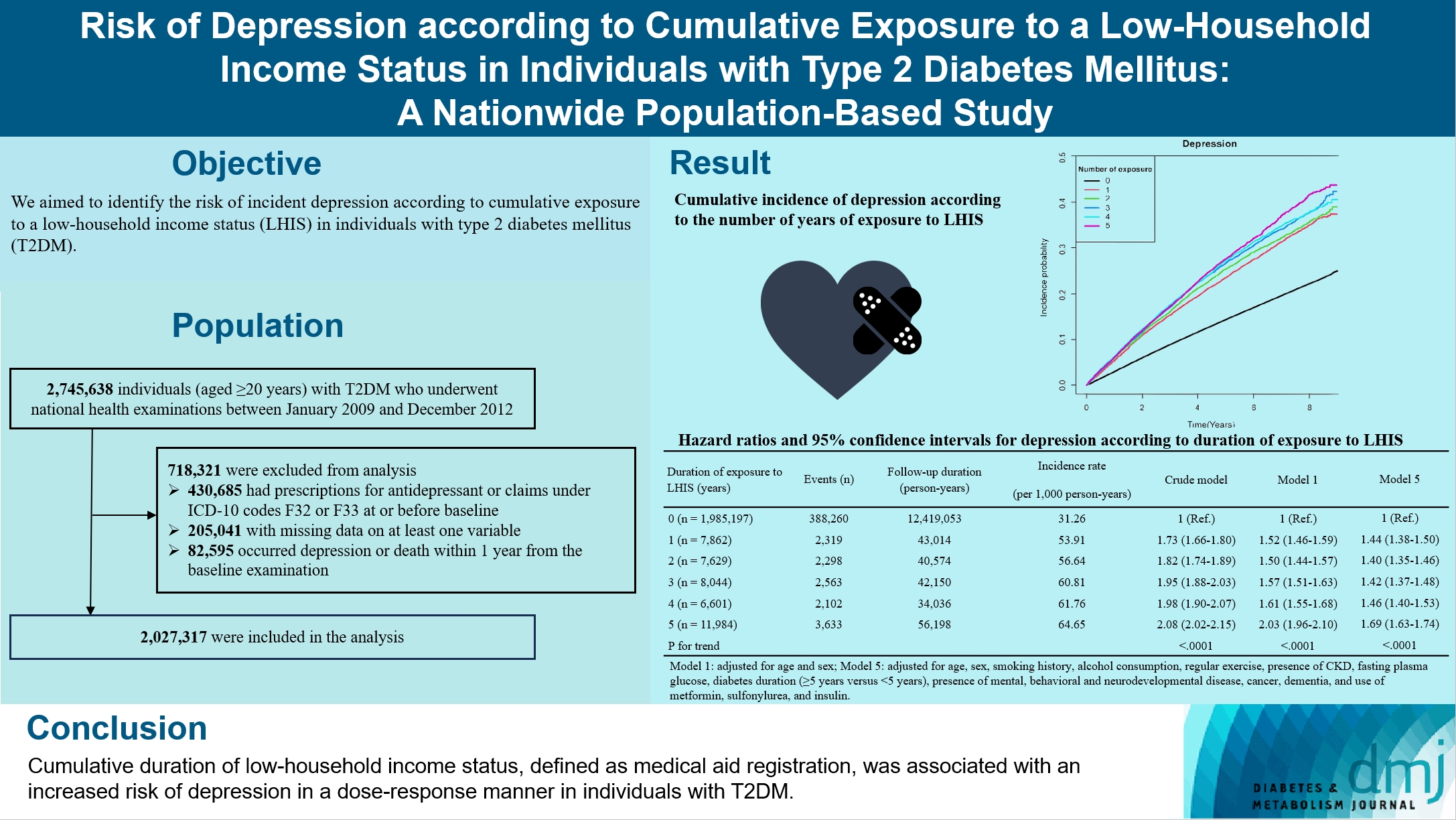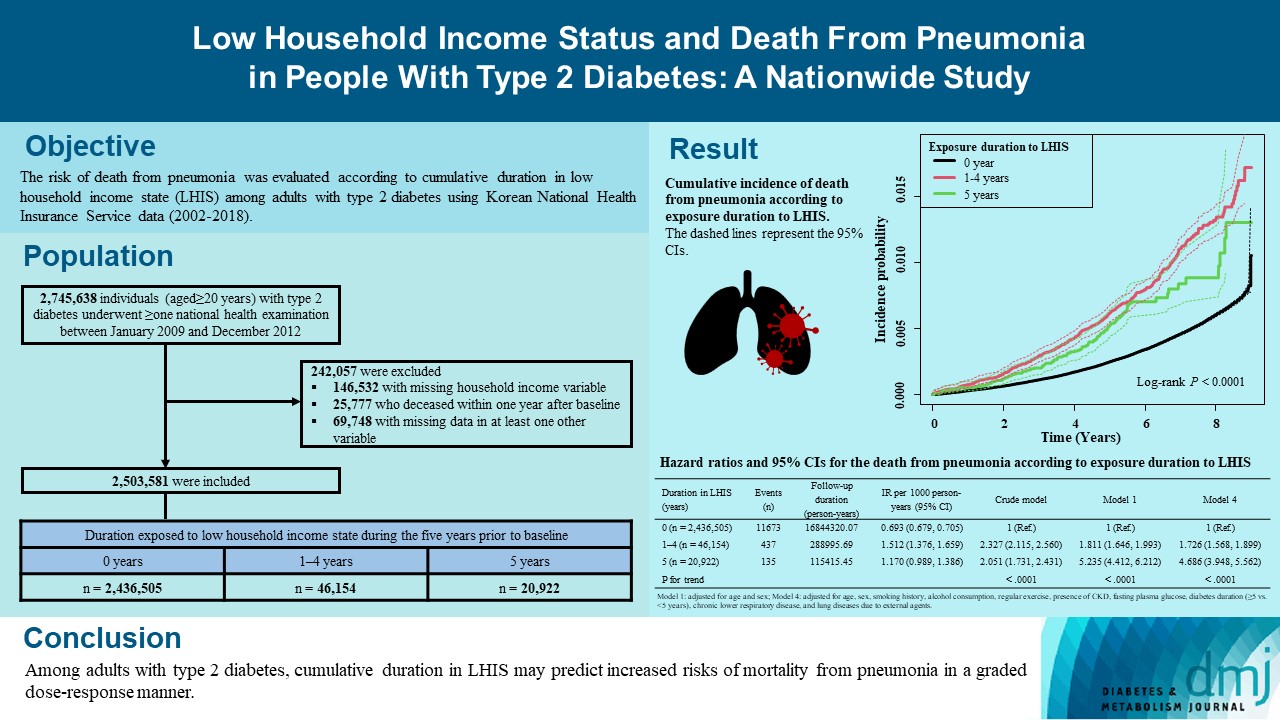
- Current
- Browse
- Collections
-
For contributors
- For Authors
- Instructions to authors
- Article processing charge
- e-submission
- For Reviewers
- Instructions for reviewers
- How to become a reviewer
- Best reviewers
- For Readers
- Readership
- Subscription
- Permission guidelines
- About
- Editorial policy
Search
- Page Path
- HOME > Search
- Complications
- Risk of Depression according to Cumulative Exposure to a Low-Household Income Status in Individuals with Type 2 Diabetes Mellitus: A Nationwide Population- Based Study
- So Hee Park, You-Bin Lee, Kyu-na Lee, Bongsung Kim, So Hyun Cho, So Yoon Kwon, Jiyun Park, Gyuri Kim, Sang-Man Jin, Kyu Yeon Hur, Kyungdo Han, Jae Hyeon Kim
- Diabetes Metab J. 2024;48(2):290-301. Published online January 3, 2024
- DOI: https://doi.org/10.4093/dmj.2022.0299

- 938 View
- 140 Download
-
 Abstract
Abstract
 PDF
PDF Supplementary Material
Supplementary Material PubReader
PubReader  ePub
ePub - Background
We aimed to identify the risk of incident depression according to cumulative exposure to a low-household income status in individuals with type 2 diabetes mellitus (T2DM).
Methods
For this retrospective longitudinal population-based cohort study, we used Korean National Health Insurance Service data from 2002 to 2018. Risk of depression was assessed according to cumulative exposure to low-household income status (defined as Medical Aid registration) during the previous 5 years among adults (aged ≥20 years) with T2DM and without baseline depression who underwent health examinations from 2009 to 2012 (n=2,027,317).
Results
During an average 6.23 years of follow-up, 401,175 incident depression cases occurred. Advance in cumulative number of years registered for medical aid during the previous 5 years from baseline was associated with an increased risk of depression in a dose-dependent manner (hazard ratio [HR], 1.44 [95% confidence interval (CI), 1.38 to 1.50]; HR, 1.40 [95% CI, 1.35 to 1.46]; HR, 1.42, [95% CI, 1.37 to 1.48]; HR, 1.46, [95% CI, 1.40 to 1.53]; HR, 1.69, [95% CI, 1.63 to 1.74] in groups with 1 to 5 exposed years, respectively). Insulin users exposed for 5 years to a low-household income state had the highest risk of depression among groups categorized by insulin use and duration of low-household income status.
Conclusion
Cumulative duration of low-household income status, defined as medical aid registration, was associated with an increased risk of depression in a dose-response manner in individuals with T2DM.
- Metabolic Risk/Epidemiology
- Low Household Income Status and Death from Pneumonia in People with Type 2 Diabetes Mellitus: A Nationwide Study
- You-Bin Lee, So Hee Park, Kyu-na Lee, Bongsung Kim, So Yoon Kwon, Jiyun Park, Gyuri Kim, Sang-Man Jin, Kyu Yeon Hur, Kyungdo Han, Jae Hyeon Kim
- Diabetes Metab J. 2023;47(5):682-692. Published online June 22, 2023
- DOI: https://doi.org/10.4093/dmj.2022.0184

- 1,612 View
- 121 Download
-
 Abstract
Abstract
 PDF
PDF Supplementary Material
Supplementary Material PubReader
PubReader  ePub
ePub - Background
We explored the risk of death from pneumonia according to cumulative duration in low household income state (LHIS) among adults with type 2 diabetes mellitus (T2DM).
Methods
Using Korean National Health Insurance Service data (2002 to 2018), the hazards of mortality from pneumonia were analyzed according to duration in LHIS (being registered to Medical Aid) during the 5 years before baseline (0, 1–4, and 5 years) among adults with T2DM who underwent health examinations between 2009 and 2012 (n=2,503,581). Hazards of outcomes were also compared in six groups categorized by insulin use and duration in LHIS.
Results
During a median 7.18 years, 12,245 deaths from pneumonia occurred. Individuals who had been exposed to LHIS had higher hazards of death from pneumonia in a dose-response manner (hazard ratio [HR], 1.726; 95% confidence interval [CI], 1.568 to 1.899 and HR, 4.686; 95% CI, 3.948 to 5.562 in those exposed for 1–4 and 5 years, respectively) compared to the non-exposed reference. Insulin users exposed for 5 years to LHIS exhibited the highest outcome hazard among six groups categorized by insulin use and duration in LHIS.
Conclusion
Among adults with T2DM, cumulative duration in LHIS may predict increased risks of mortality from pneumonia in a graded dose-response manner. Insulin users with the longest duration in LHIS might be the group most vulnerable to death from pneumonia among adults with T2DM.
- Clinical Care/Education
- Impact of Socioeconomic Status on Health Behaviors, Metabolic Control, and Chronic Complications in Type 2 Diabetes Mellitus
- So Hun Kim, Seung Youn Lee, Chei Won Kim, Young Ju Suh, Seongbin Hong, Seong Hee Ahn, Da Hae Seo, Moon-Suk Nam, Suk Chon, Jeong-Taek Woo, Sei Hyun Baik, Yongsoo Park, Kwan Woo Lee, Young Seol Kim
- Diabetes Metab J. 2018;42(5):380-393. Published online June 29, 2018
- DOI: https://doi.org/10.4093/dmj.2017.0102
- 4,843 View
- 67 Download
- 11 Web of Science
- 15 Crossref
-
 Abstract
Abstract
 PDF
PDF Supplementary Material
Supplementary Material PubReader
PubReader Background The aim of the study was to assess the impact of socioeconomic status (SES) on health behaviors, metabolic control, and chronic complications in people with type 2 diabetes mellitus (T2DM) from South Korea, a country with universal health insurance coverage and that has experienced rapid economic and social transition.
Methods A total of 3,294 Korean men and women with T2DM aged 30 to 65 years, participating in the Korean National Diabetes Program (KNDP) cohort who reported their SES and had baseline clinical evaluation were included in the current cross-sectional analysis. SES included the level of education and monthly household income.
Results Lower education level and lower income level were closely related, and both were associated with older age in men and women. Women and men with lower income and education level had higher carbohydrate and lower fat intake. After adjustment for possible confounding factors, higher education in men significantly lowered the odds of having uncontrolled hyperglycemia (glycosylated hemoglobin ≥7.5%) (odds ratio [OR], 0.63; 95% confidence interval [CI], 0.43 to 0.91 for highest education;
P trend=0.048), while higher household income in men significantly lowered the odds of having diabetic retinopathy (OR, 0.59; 95% CI, 0.37 to 0.95 for highest income level;P trend=0.048). In women, lower income was associated with a higher stress level.Conclusion Men with lower SES had higher odds of having diabetic retinopathy and uncontrolled hyperglycemia, showing the need to improve care targeted to this population.
-
Citations
Citations to this article as recorded by- A Scoping Review of Possible Solutions for Decreasing Socioeconomic Inequalities in Type 2 Diabetes Mellitus
Laleh Gharacheh, Mostafa Amini-Rarani, Amin Torabipour, Saeed Karimi
International Journal of Preventive Medicine.2024;[Epub] CrossRef - Socioeconomic status and the effect of prolonged pandemic confinement on anthropometric and glycaemic outcomes in adults with type 2 diabetes mellitus
Chandana Wijeweera, Ummul Muhfaza, Reginald V. Lord, Peter Petocz, Juliana Chen, Veronica Preda
Primary Care Diabetes.2024;[Epub] CrossRef - Income variability and incident cardiovascular disease in diabetes: a population-based cohort study
Yong-Moon Mark Park, Jong-Ha Baek, Hong Seok Lee, Tali Elfassy, Clare C Brown, Mario Schootman, Marie-Rachelle Narcisse, Seung-Hyun Ko, Pearl A McElfish, Michael R Thomsen, Benjamin C Amick, Seong-Su Lee, Kyungdo Han
European Heart Journal.2024;[Epub] CrossRef - Association of diet quality with glycemia, insulinemia, and insulin resistance in families at high risk for type 2 diabetes mellitus in Europe: Feel4 Diabetes Study
Botsi E, Karatzi K, Mavrogianni C, Kaloyan Tsochev, Esther M González-Gil, Radó S, Kivelä J, Wikström K, Cardon G, Rurik I, Liatis S, Tsvetalina Tankova, Violeta Iotova, Luis A. Moreno, Makrillakis K, Manios Y, Tsigos C
Nutrition.2023; 105: 111805. CrossRef - Sustained Low Income, Income Changes, and Risk of All-Cause Mortality in Individuals With Type 2 Diabetes: A Nationwide Population-Based Cohort Study
Hong Seok Lee, Jimin Clara Park, Inkwan Chung, Junxiu Liu, Seong-Su Lee, Kyungdo Han
Diabetes Care.2023; 46(1): 92. CrossRef - Association of birth weight with risk of diabetes mellitus in adolescence and early adulthood: analysis of the Indonesian Family Life Survey
Ratu Ayu Dewi Sartika, Fathimah Sulistyowati Sigit, Edy Purwanto, Norliyana Aris, Avliya Quratul Marjan, Wahyu Kurnia Yusrin Putra, Sutanto Priyo Hastono
Annals of Pediatric Endocrinology & Metabolism.2023; 28(4): 267. CrossRef - Effects of Diabetes Quality Assessment on Diabetes Management Behaviors Based on a Nationwide Survey
Chang Kyun Choi, Jungho Yang, Ji-An Jeong, Min-Ho Shin
International Journal of Environmental Research and Public Health.2022; 19(23): 15781. CrossRef - FOLLOW-UP ADHERENCE IN PATIENTS WITH NONPROLIFERATIVE DIABETIC RETINOPATHY PRESENTING TO AN OPHTHALMIC EMERGENCY DEPARTMENT
Arjun Watane, Meghana Kalavar, Elizabeth A. Vanner, Kara Cavuoto, Jayanth Sridhar
Retina.2021; 41(6): 1293. CrossRef - Socioeconomic disparity in global vision loss burden due to diabetic retinopathy: an analysis on time trends from 1990 to 2017
Yi Shan, Yufeng Xu, Lingxia Ye, Xiling Lin, Yaoyao Chen, Qi Miao, Juan Ye
Endocrine.2021; 73(2): 316. CrossRef - Tip 2 Diyabetli Bireylerin Hastalık Yönetiminde Karşılaştıkları Engellerin Değerlendirilmesi
Şuheda ÜSTÜNDAĞ, Nuray DAYAPOĞLU
Adnan Menderes Üniversitesi Sağlık Bilimleri Fakültesi Dergisi.2021; 5(3): 514. CrossRef - Socioeconomic inequalities in type 2 diabetes in employed individuals, nonworking spouses and pensioners
Batoul Safieddine, Stefanie Sperlich, Johannes Beller, Karin Lange, Jelena Epping, Juliane Tetzlaff, Fabian Tetzlaff, Siegfried Geyer
SSM - Population Health.2020; 11: 100596. CrossRef - Thirteen-year trends in the prevalence of diabetes according to socioeconomic condition and cardiovascular risk factors in a Swiss population
Carlos de Mestral, Silvia Stringhini, Idris Guessous, François R Jornayvaz
BMJ Open Diabetes Research & Care.2020; 8(1): e001273. CrossRef - Dietary Habits and Dietary Antioxidant Intake Are Related to Socioeconomic Status in Polish Adults: A Nationwide Study
Małgorzata Elżbieta Zujko, Anna Waśkiewicz, Wojciech Drygas, Alicja Cicha-Mikołajczyk, Kinga Zujko, Danuta Szcześniewska, Krystyna Kozakiewicz, Anna Maria Witkowska
Nutrients.2020; 12(2): 518. CrossRef - Diabetes Fact Sheets in Korea, 2018: An Appraisal of Current Status
Bo-Yeon Kim, Jong Chul Won, Jae Hyuk Lee, Hun-Sung Kim, Jung Hwan Park, Kyoung Hwa Ha, Kyu Chang Won, Dae Jung Kim, Kyong Soo Park
Diabetes & Metabolism Journal.2019; 43(4): 487. CrossRef - Gender in Endocrine Diseases: Role of Sex Gonadal Hormones
R. Lauretta, M. Sansone, A. Sansone, F. Romanelli, M. Appetecchia
International Journal of Endocrinology.2018; 2018: 1. CrossRef
- A Scoping Review of Possible Solutions for Decreasing Socioeconomic Inequalities in Type 2 Diabetes Mellitus

 KDA
KDA
 First
First Prev
Prev





